Journalist Angus McIntyre hits the road with veteran truckie Frank Black
The clattering and jarring in Frank Black’s 22-wheel semi trailer as he hauls along the Western Highway perfectly highligts the perilous state of Victoria’s roads.
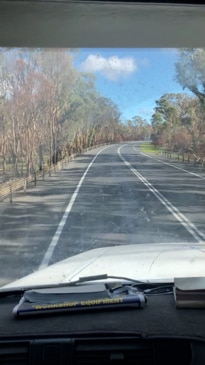
VWeekend
Don't miss out on the headlines from VWeekend. Followed categories will be added to My News.
“You’ve really got to think sometimes, what am I doing out here?”
Mountains at the northern end of the Grampians provide a dramatic backdrop to the Western Highway near Stawell, about three hours northwest of Melbourne.
The landscape is bathed in the midmorning sun – it’s a picture-perfect winter’s morning.
In the cabin of truckie Frank Black’s 22-wheel semi trailer, we’re being thrown around as if we’re on a ship on rough seas rather than a large vehicle on a major Australian road.
“Absolutely shocking, but this is pretty mild,” Black says of the road.
“If we were carrying a heavy load it would be 10 times worse.”
As my bones jangle and teeth clatter in the seat next to Black, I shudder to think what 10 times worse would be like.
Large portions of the Western Highway, which according to Black was once known as one of the best roads in Australia, are in a dire condition.
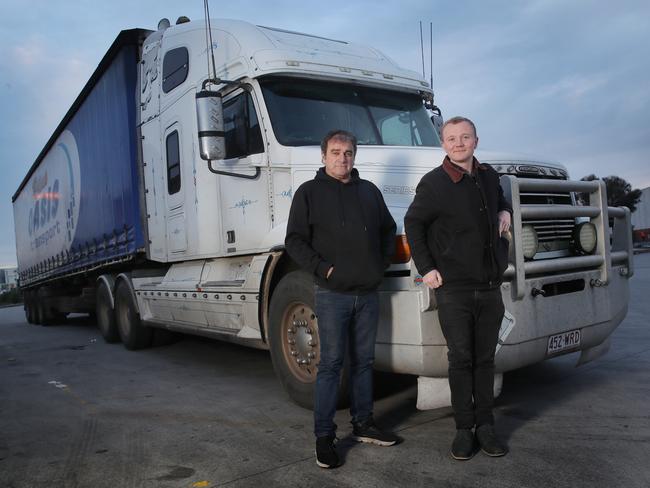
A patchwork of half-fixes and filled-in potholes has left the road, extending from Derrimut on Melbourne’s edge all the way to the South Australian border, feeling like a rollercoaster from the height of our cabin. Black has been fighting an on-again off-again battle with his steering wheel for much of our journey, using all 35 years of his experience to keep our massive vehicle on a true path west towards Adelaide.
The 63-year-old father of three and grandfather of four knows what he’s doing, having carried everything from dangerous goods to an elephant in three and a half decades crisscrossing the great Australian landmass.
“All it takes is one driver who is inexperienced or who isn’t paying attention hitting a bump or a divot and they could be thrown into the other lane or oncoming traffic,” he says. “You don’t need potholes to make a road dangerous.”
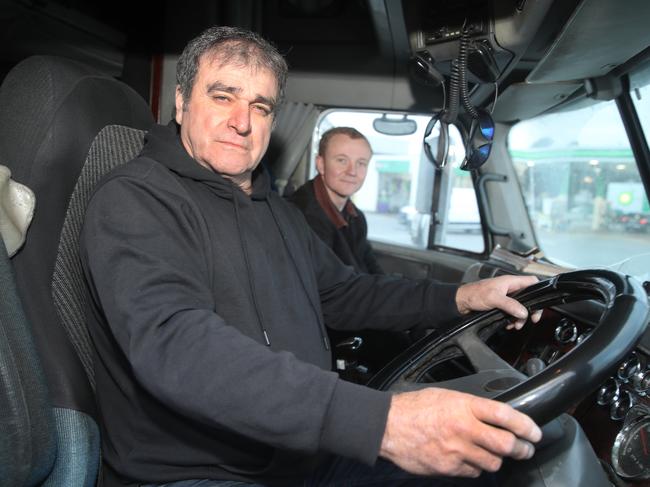
While the highway may be less strewn with potholes than many of Victoria’s smaller regional roads, its status as one of the busiest freight lanes in Australia makes its condition alarming. There were 177 crashes on just the section of the Western Highway between Ballarat and Stawell in the 10 years prior to July 2023.
A total of 18 people died and 104 were seriously injured.
Nearly two and a half thousand trucks use the highway every single day as they ferry goods between Melbourne and Adelaide.
Portions of the highway are undergoing upgrades as part of Victoria’s much-hyped Big Build, with a joint investment of $656m between state and federal governments to upgrade the road between Ballarat and Stawell.
The upgrade has been slow going, with only 55km of duplication achieved in over a decade.
“Since 2013, we have delivered 55km of duplication between Ballarat and Buangor – with the Western Highway Upgrade set to improve reliability and motorist safety,” a Victorian government spokesman says.
However, the part of the road currently being upgraded only stretches as far west as Stawell, leaving another 200km of rough, uneven highway before we reach the border.
Road safety advocates say current upgrade plans aren’t enough.
“Given the importance of the Western Highway to both motorists and the transport industry, RACV will advocate for upgrades along its entire route,” RACV head of policy James Williams says.
Black agrees it’s needed, but with the resigned air of someone who over the years has been let down by scores of politicians, whether they wear a blue or red tie.
“It doesn’t matter which government’s in, they just patch it up,” he says.
“As far as I am concerned it should be torn up and relaid.
“It’s sad that some poor bugger’s going to have to lose their life to spur the government to do something.”
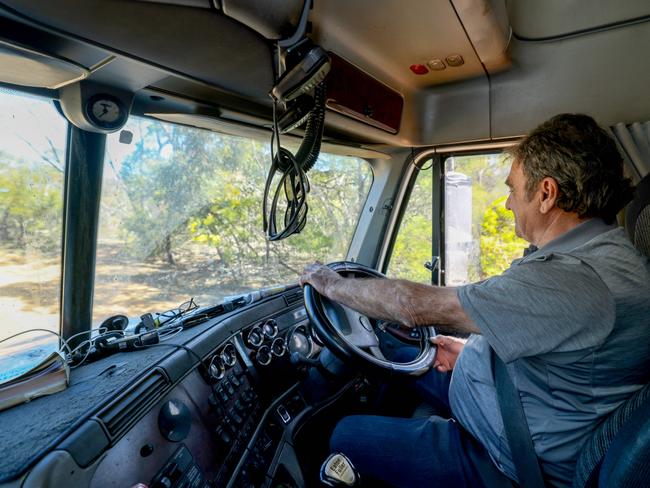
The state government did not respond to further detailed questions regarding the need to fix up the entirety of the road.
A section of the Western Highway was one of the most complained about roads in the entire state in a survey undertaken by the RACV this year.
“The Western Highway between Trawalla and Beaufort was ranked number six in regional Victoria in terms of issues raised during the RACV My Country Road survey conducted this year,” Williams says.
“The main concern raised by motorists on this section of the Western Highway was potholes and poor road condition.”
State opposition roads spokesman Danny O’Brien says the condition of the highway is a bad look for Victoria.
“The Western Highway is like many Victorian roads – little better than a goat track in some parts,” O’Brien says.
“As a major connecting highway to South Australia it’s a poor reflection on our great state.
“This is due to successive years of budget cuts in road maintenance and abject neglect of our state’s roads.”
Problems with Victoria’s roads appear to be getting worse, with 64 per cent of respondents to the RACV survey identifying potholes and poor road condition as the primary safety issue on regional roads; up from 46 per cent in 2021.
The awful state of some roads does not just pose a safety issue; it can hit drivers – already operating on thin margins – in the pocket too.
Long journeys on a bumpy road often dislodge something in a driver’s load or cause mechanical issues.
A police officer who pulls over a truck driver and finds something wrong with their vehicle can issue anything from a written warning to a fine of several hundred dollars.
The grim irony, as Frank puts it, is “not only has the government given me a shit road to drive on, but they fine me for the pleasure of breaking my truck.
“You leave home and everything’s fine, you get on these busted-arse roads and something breaks.
“They charge us enough in road taxes and so on to keep and maintain these roads,” Black says. “Where is it?”
Fines are just one of the financial pitfalls which await a modern truck driver.
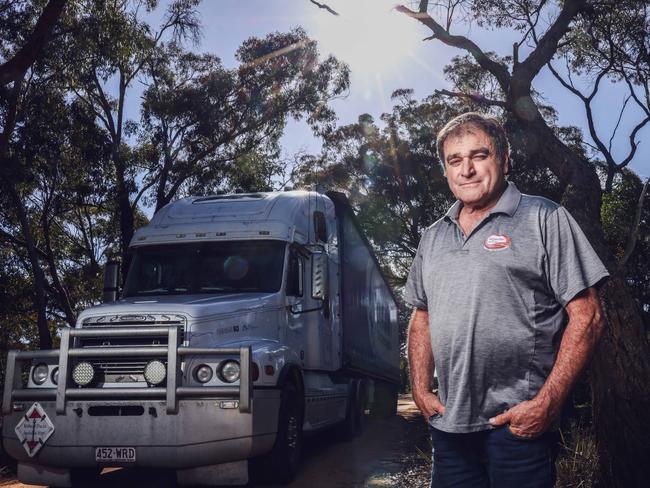
Unfair payment terms, sometimes up to 120 days, skyrocketing fuel prices and pressure to constantly deliver against ever-tighter deadlines in the face of undercutting from suppliers and the gig economy are some of the other factors putting excessive strain on the industry.
There is the added pressure of having to pay for your own fuel and maintenance, whether you are a transport business or a self-employed owner-driver like Black.
There is hope in the industry that the federal government’s Closing the Loophole legislation, which will introduce automatic rights for contractors and allow the Fair Work Commission to introduce minimum standards throughout much of the transport industry, is an important first step in addressing the issues.
“This crisis in road transport has united the industry like never before,” Transport Workers Union national secretary Michael Kaine says.
“The TWU along with employer associations, transport operators and other industry figures campaigned to secure laws which, when they take effect at the end of this month, will be able to begin making this industry safer and fairer.”
The Grampians slowly fade in the rearview mirror, giving way to vast expanses of farmland either side of the regional city of Horsham.
Inside our cabin, the rattling and shaking remains constant despite the changing landscape. There’s only so much you can discuss about a bumpy road, so Black and I turn our conversation to his fears about the future of the industry.
Trucking and transport is one of Australia’s most important business sectors.
Long haul truck drivers are routinely referred to in reverential terms such as “the backbone of the economy”.
As a sign attached to Black’s bullbar puts it more bluntly, “Without trucks Australia stops”.
Trucking is also one of our most deadly industries.
Last year, 54 truck drivers were killed in crashes, at a rate of over one a week, according to data collected by the TWU.
The grim run rate of one truckie dying every week has been maintained so far in 2024.
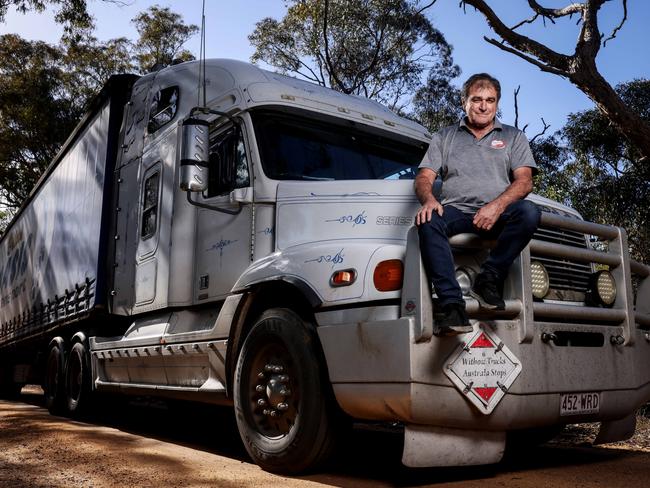
Black has lost four good friends to accidents over the years, and many more acquaintances.
He was almost killed himself in a near miss six months ago, when another truck either didn’t see him or misjudged a distance when pulling out at a junction near Balranald, in the Murray region of NSW, not far from the Victorian border.
“It makes you think, is it time to give it away before it’s your turn?”
As Black reminds me, if a truck hits another truck “this little tin box cabin isn’t going to do much for you”.
“One of these things can cause so much destruction,” he says bluntly.
Speeding past other heavy vehicles on our bumpy road, I take the pathetic decision to double check my seatbelt is still fastened, with all the difference that would make in a head-on collision.
“The condition of the road just adds to your fatigue,” Black says.
“When you’re bouncing around your cab all day it tires you out.”
The poor quality of many roads is just one factor which makes long haul driving so dangerous.
Drivers are “teetering on razor-thin margins and under pressure to delay maintenance (to trucks), speed, and drive fatigued to make ends meet,” Michael Kaine says.
Little wonder the industry is facing a driver shortage crisis, with around 26,000 driver positions unfilled around the country according to a July survey from the International Road Transport Union.
One of the few politicians Black isn’t disappointed by is WA Senator Glenn Sterle, a long-term advocate for the transport industry as a former truckie himself.
“Our industry is rife with shortages,” Sterle says. “We’ve been faced with this for many, many years.
“We don’t have 26,000-plus 15, 16, 17 year-olds waiting in high school about to become forkies (forklift drivers) and truckies. That’s pretty serious, mate.”
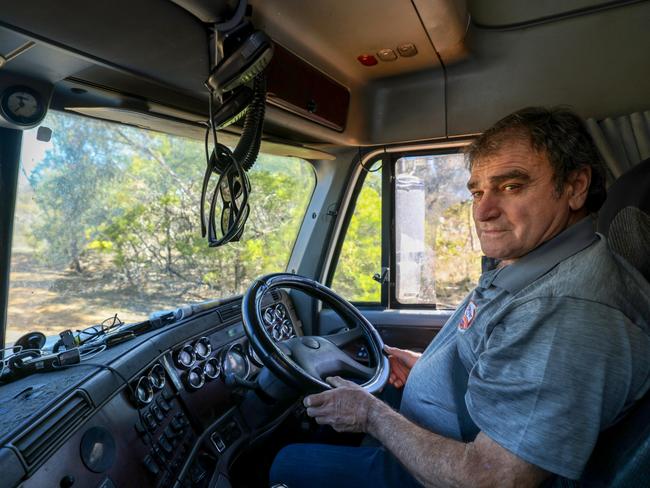
To its credit, the federal government appears to be taking the matter seriously, with a raft of further legislation due by the end of the year.
“A package of safety and productivity reforms to the Heavy Vehicle National Law (HVNL) is being progressed, which includes a better safety assurance environment, enhancements to the National Heavy Vehicle Accreditation Scheme, and improvements to fatigue management,” a spokesman for the Department of Infrastructure, Transport, Regional Development, Communications and the Arts says.
“The package of reforms is due to be delivered to Commonwealth, state and territory ministers in December 2024. Agreed amendments will then be prepared for introduction into the Queensland Parliament, as host jurisdiction for the HVNL.”
Whether that will be enough to attract a new generation of truckies to keep the country going, only time will tell.
Our truck crosses into South Australia shortly after 2pm.
The difference in the road is noticeable immediately, with only the odd bump here and there in stark contrast to the near constant rattling we have endured for the previous six hours.
“Chalk and cheese,” Black says ruefully. “If South Australia can do it, why can’t Victoria?”
Given the undeniable difference in quality, you can’t accuse Black of some South Australian home bias.
Born in Adelaide to immigrants who fled the abject poverty of post-war Southern Italy, Black grew up near the docks in a melting pot neighbourhood filled with Slavs, Greeks and Italians.
He would have been “flogged” if he barracked for anyone other than Port Adelaide, he says without appearing to be joking. Black has been a truck driver since he bought a battered old vehicle aged 28 and fixed it up himself, using skills acquired in his first job as a mechanic.
Time on the road has now taken up more than half of his quintessentially Australian life.
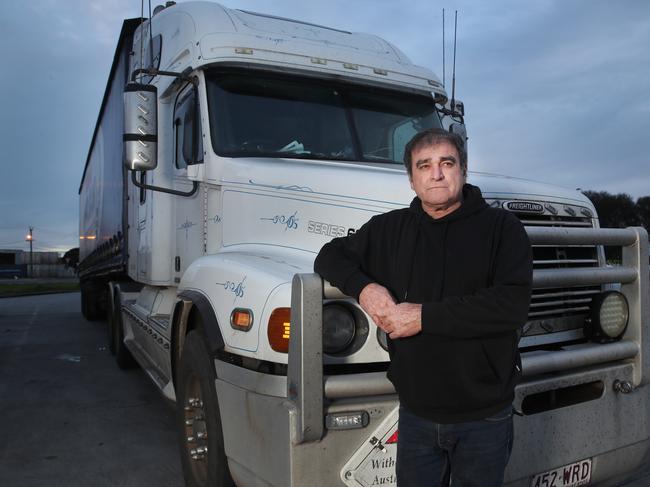
The toll has occasionally been immense, contributing to a strained relationship with his three kids throughout much of their childhood.
“I was the bad man who came home to tell them off every fortnight,” he says. Father-children relations have thankfully recovered over time and Black is determined to not let his profession impact his relationship with his grandchildren in the same way.
“I missed mine a lot when they were young so I bust my arse to see my grandkids,” he says, beaming with pride as he goes on to tell me about his grandson recently bagging four goals in a single soccer match.
Black’s own marriage eventually collapsed after 17 years, he says mainly due to the stress of him constantly being on the road.
“I’m working on it,” he tells me of his current dating life.
Unsurprisingly, divorce rates are high in long-haul transport, and the industry as a whole also suffers from terrible mental health outcomes.
“Trucking is one of the lowest ranked industries in Australia when it comes to worker mental health,” Beyond Blue’s clinical psychologist and clinical spokesman, Dr Luke Martin, says.
“By the very nature of the work truckers do, it places them at higher risk for experiencing anxiety and depression than the general population. Sadly, truck drivers are at an even higher risk of suicide than other male-dominated industries.”
Black takes care of his own mental health out on the road in a variety of ways.
He has used the many nights spent sleeping in the bunk bed directly behind his driver’s seat to teach himself guitar. He says he’s not bad.
“I won’t serenade you, don’t worry.”
As with everything, the spectre of automation looms over the trucking industry.
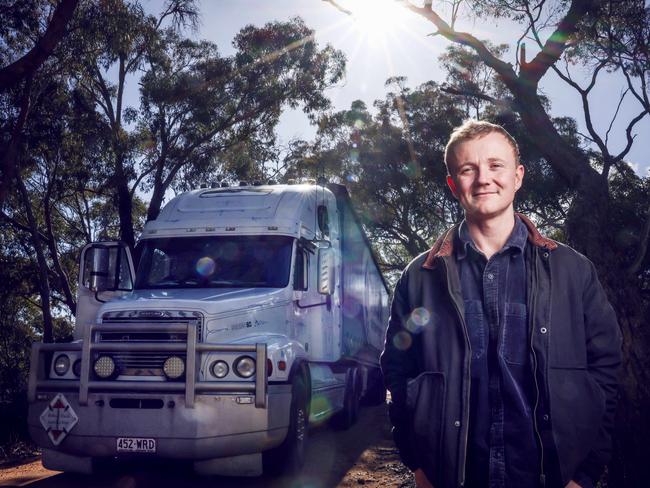
Black concedes that self-driving trucks will eventually put paid to a lot of the issues we’ve discussed during our day on the road.
However even if, as several experts tell me, the technology is already there, the magnitude of the infrastructure and safety challenges which would need to be addressed means that Australia will be needing truck drivers for a while longer yet.
Despite everything he’s told me about trucking, Black still thinks enough people can be attracted to save the short term future of the sector provided it can offer people what ultimately we all strive for: basic guarantees around pay, working conditions and safety.
“I don’t think we’re asking for much,” he says.
“A fair day’s pay for a fair day’s work, to be treated with respect and to not kill ourselves or anyone else.”
We make the picturesque descent into the South Australian capital through the rolling Adelaide Hills at the most inopportune moment imaginable; the setting sun over the western horizon shines directly into Black’s face and threatens to derail us at our final hurdle. But he drops me in Adelaide safely as night falls.
I’ll be flying back to Melbourne in the morning – Black will rest for a day, then be back on the road.



